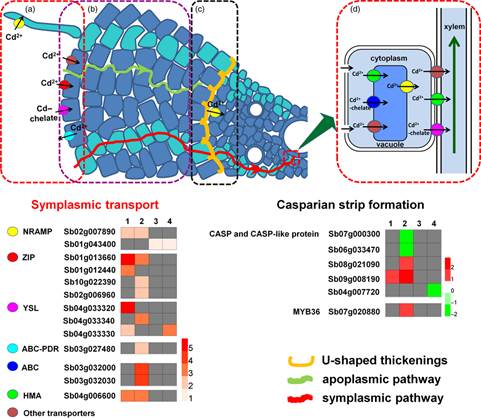甜高粱吸收重金属镉分子机理研究取得进展

镉污染问题严重威胁着粮食安全和人类健康,如何有效治理土壤镉污染愈发受到人们的关注。作为最具前景的生物质能源植物之一,甜高粱具有茎秆含糖量高、生长周期短、生物量大、抗逆性强、适种范围广等优势,利用其修复镉污染土壤,茎秆和籽粒生产燃料乙醇,酒糟用于燃烧发电,镉元素可从灰烬中加以回收。这样镉就从食物链转移到能源链中,兼顾了生态和经济效益。目前人们对甜高粱吸收镉的研究较少,且多局限于生理层面。同时,甜高粱作为非超富集植物,吸收的镉多储存于根中,限制了其从污染土壤中提取镉的能力。因此,解析甜高粱吸收镉的生理和分子机理、促进镉从根向地上部分的转运是提高甜高粱吸收镉能力的重要前提。
中国科学院植物研究所李银心研究组对来自全球不同地区的96个甜高粱品系进行了筛选,发现不同品系对镉的耐受、吸收和转运能力具有很大差异。根据筛选结果,研究人员以镉转运能力强和弱的两个甜高粱品系H18和L69(镉转运系数相差4倍)为材料,针对影响甜高粱吸收和转运镉的关键因素开展研究。研究结果表明,H18通过共质体途径吸收的镉显著高于L69,且其根的内皮层中质外体屏障较L69更弱,木质部汁液中镉的含量也更高。研究人员利用比较转录组学,通过分析两个品系间的差异表达基因及镉响应基因的异同,将镉转运能力差异主要聚焦到苯丙素和木质素合成以及细胞壁修饰过程。同时,一些金属转运蛋白基因的差异表达也可能是导致两个甜高粱品系对镉吸收和转运能力不同的重要原因。由此,研究人员提出根的吸收、细胞壁的结合、内皮层的阻隔作用,以及木质部装载等多个过程的协同作用决定了甜高粱对镉的吸收和转运能力。
该研究从生理、细胞和分子水平初步揭示了甜高粱吸收镉的机理,鉴定出多个影响镉吸收和转运的关键基因,为利用生物技术提高甜高粱吸收镉的能力提供了新的靶标和思路。
研究成果在线发表在Plant Biotechnology Journal上,关于甜高粱吸收镉的品系筛选研究发表在Ecotoxicology and Environmental Safety上。该研究工作得到了国家重点研发项目和国家科技惠民计划的资助。(来源:中科院植物研究所)
Comparative transcriptome combined with morpho-physiological analyses revealed key factors for differential cadmium accumulation in two contrasting sweet sorghum genotypes
Abstract Cadmium (Cd) is a widespread soil contaminant threatening human health. As an ideal energy plant, sweet sorghum (Sorghum bicolor (L.) Moench) has great potential in phytoremediation of Cd-polluted soils, although the molecular mechanisms are largely unknown. In this study, key factors responsible for differential Cd accumulation between two contrasting sweet sorghum genotypes (high-Cd accumulation one H18, and low-Cd accumulation one L69) were investigated. H18 exhibited a much higher ability of Cd uptake and translocation than L69. Furthermore, Cd uptake through symplasmic pathway and Cd concentrations in xylem sap were both higher in H18 than those in L69. Root anatomy observation found the endodermal apoplasmic barriers were much stronger in L69, which may restrict the Cd loading into xylem. The molecular mechanisms underlying these morpho-physiological traits were further dissected by comparative transcriptome analysis. Many genes involved in cell wall modification and heavy metal transport were found to be Cd-responsive DEGs and/or DEGs between these two genotypes. KEGG pathway analysis found phenylpropanoid biosynthesis pathway was over-represented, indicating this pathway may play important roles in differential Cd accumulation between two genotypes. Based on these results, a schematic representation of main processes involved in differential Cd uptake and translocation in H18 and L69 is proposed, which suggests that higher Cd accumulation in H18 depends on a multilevel coordination of efficient Cd uptake and transport, including efficient root uptake and xylem loading, less root cell wall binding, and weaker endodermal apoplasmic barriers.
原文链接:http://onlinelibrary.wiley.com/doi/10.1111/pbi.12795/pdf
Identification for the capability of Cd-tolerance, accumulation and translocation of 96 sorghum genotypes
Abstract Cadmium (Cd) pollution is a worldwide environmental problem which heavily threatens human health and food security. Sorghum, as one of the most promising energy crop, has been considered to be the source of high-quality feedstock for ethanol fuel. Ninety-six sorghum genotypes were investigated under hydroponic conditions to compare their capabilities of Cd-tolerance, accumulation and translocation for their potential in remediation of Cd contamination. Different genotypes varied largely in the tolerance to Cd stress with tolerance indexes ranked from 0.107 to 0.933. Great difference was also found in Cd uptake and accumulation with concentrations ranging from 19.0 to 202.4 mg/kg in shoots and 277.0–898.3 mg/kg in roots. The total amounts of Cd ranked from 6.1 to 25.8 μg per plant and the highest translocation factor was over 4 times higher than the lowest one. The correlation analysis demonstrated that Cd concentration in shoot reflected the ability of Cd translocation and tolerance of sorghum, and the path coefficient analysis indicated that root biomass could be taken as a biomarker to evaluate Cd extraction ability of sorghum. The results in this study can facilitate the restoring of Cd contaminated areas by sorghum.
原文链接:http://ac.els-cdn.com/S0147651317304189/1-s2.0-S0147651317304189-main.pdf?_tid=eda5bc5a-9cd4-11e7-b607-00000aab0f6c&acdnat=1505782580_744349a2a938c3133d7410bb1580b721

